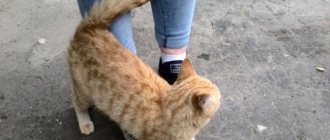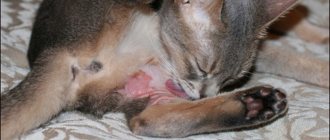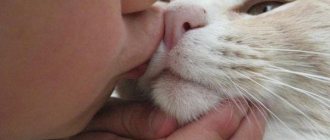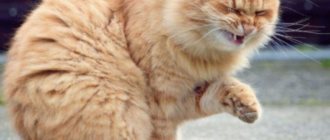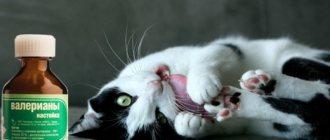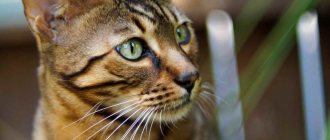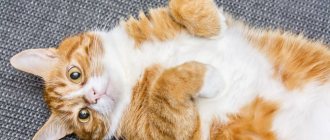We all know how soft cat fur feels under our fingertips and how impeccable their hygiene is. However, as a cat owner, I am accustomed to ailments that most cats have to contend with at least once in their lives. More importantly, I know that some of them may be a sign of a larger problem. So, when I noticed an excessive amount of loose hair around my house, the only question I thought was - why does my cat's hair fall out in clumps?
Some may think that hair loss in cats is quite common. We've all seen how much hair is left on our clothes when a feline leaves our lap after a short cuddle session. However, if the fur is falling out in clumps, it may be a sign that your cat needs to be taken to the vet.
About feline alopecia
Due to stress or some other factors, hair may begin to fall out in clumps, leaving a receding hairline all over.
The same thing can happen with cats. Alopecia in cats is a fairly common problem and comes in several forms. It can be partial or complete, and the cat can lose hair symmetrically or in a completely random pattern.
The problem is that hair loss in cats can be caused by almost anything. Some triggers require careful testing, especially since some cats may be born with it.
© shutterstock
Age
It is very important for owners to understand as early as possible why cats lose hair in clumps. The reasons can be completely different, from dangerous to completely harmless. Baldness of the muzzle and partial loss of hair are another common condition of the animal. This process manifests itself in pets aged from 14 months to 20. This condition is caused by quite normal age-related changes in the coat. When the animal reaches the appropriate age, this phenomenon will go away on its own, so you should not run to the veterinarian.
Fleas
Owning a dog and a cat, or living in an area where the cat has easy access to the outdoors, may be the reason your feline suddenly loses its fur in clumps. If a cat is able to go outside and socialize in nature or is in close contact with a dog every day, he may be bitten by a flea.
Now the cat can avoid losing hair because of the fleas themselves. The cause of baldness in this case is an allergy to flea bites. If a feline is sensitive to flea saliva, it may develop alopecia, especially in the hindquarters.
Unfortunately, it only takes one flea to cause a rather unpleasant and sometimes long-lasting reaction. This is why it is important to take your cat to the vet immediately to avoid further damage to the skin and fur.
Luckily, this condition is easy to treat with some flea treatments and shampoo. If the itching persists and hair loss is excessive, your veterinarian may also prescribe antihistamines or corticosteroids.
General rules for avoiding problems
Regardless of the causes of alopecia, the following recommendations will help maintain healthy skin and fur:
- Brush the coat frequently using a furminator. This will help reduce shedding. The comb massages the cat's skin, improving blood circulation.
- When bathing your animal, use medicated shampoos.
- Protect your pet from stress. If necessary, use sedatives recommended by your veterinarian.
- Regularly undergo preventive examinations by a veterinarian to stop the development of serious diseases in the early stages. Vaccinations and vaccinations will help with this.
- Add vitamin supplements to the food to improve the condition of the coat.
And remember: care and concern, love and attention to the health of a mustachioed pet also help solve problems and keep its fur coat healthy and shiny.
1111
Ticks
However, it's not just fleas that cat owners have to worry about. Mites are common on most mammals and when their populations increase dramatically, they can cause severe itching, skin lesions, and hair loss in clumps, among other things.
Mite infestations usually occur when a cat's immune system is not functioning properly. Because of this, it is not uncommon for stressed cats or felines to already have some other disease. Additionally, if hormone levels rise or the cat begins to produce excess oil, a common consequence is an outbreak of Demodex mites, and the end result is a condition called mange.
In most cases, mite infestations are evident around the cat's eyelids, flanks, head and neck. In addition to missing hairballs, his skin will also be scaly, with lesions and scabs.
To confirm the presence and determine the type of mite causing the problem, the veterinarian will scrape the skin. Sometimes hair analysis can also help in identification. You may also need to do a urine test to rule out other conditions with similar symptoms.
The good news is that in 90% of cases, demodectic scabies goes away on its own with time. However, if it is severe, long-term medications and lime-sulfur sauces may be needed to control the condition and help the cat recover.
Medicines
Removing parasites is the first step to fluffy, beautiful fur. First, an insecticidal treatment is carried out aimed at exterminating lice, fleas, and ticks. For this purpose, drops, sprays, and shampoos are purchased at the zoological pharmacy. They should be used strictly according to the instructions, without exceeding the concentration, dosage, or procedure time, so as not to poison the pet.
Be sure to read:
Why does a cat constantly scratch its chin: what kind of disease is it?
The use of dichlorvos and other chemicals not intended for cats is strictly prohibited. If there are a large number of fleas, the treatment is repeated after 7-10 days. Suprastin and diazolin in the dosage recommended by the veterinarian will help relieve itching.
3-7 days after treating the external parasites, a drug is given to remove helminths. The tablet is taken in the morning, along with food, the required dose is calculated according to the cat’s weight. If worms are found in the stool after this, you need to repeat taking the drug after 10-14 days.
Fungal infection (ringworm)
Although there is a “worm” in this disease, it is actually a fungal infection that can be easily transmitted to people. Cats usually become ill from contact with other infected animals. From there, the infection spreads and can wreak havoc on your home, whether you have a cat or a kitten.
Hair loss in clumps is the most common symptom. A ringworm infection causes the hair to become quite brittle so it breaks, leaving behind clumps. The areas most commonly affected are around the feet, ears and face.
The skin will also show signs of infection; The ears, feet and parts of the face may appear slightly reddish, and there may also be white or gray crusts. In general, hairless skin will appear dry and flaky.
Looking for an answer to the question, why does my cat's fur fall out in clumps? this infection seemed like the biggest red flag to me. Since my cat was leaving clumps of fur behind her and some of the hairless parts were quite dry to the touch, I had to confirm the diagnosis with a vet.
Fortunately, the cat recovered quickly. To confirm the infection, the veterinarian tested a fungal skin culture. Treatment included the use of various antifungal agents such as shampoos, sprays and creams. Treatment may also include oral medications, but they were not necessary in our case.
Parasites
It is a mistake to think that an animal can become infected with parasites only by living outdoors. Therefore, preventive measures are often not applied to pets that do not leave the apartment. But parasites can get into the house on people’s clothes and shoes. And then safely transfer to the animal. Several signs that help determine that an animal has parasites:
- The pet's behavior becomes nervous, it itches very often and severely, which even leads to the appearance of wounds.
- The hair falls out, but not very much.
- The direct presence of parasites on an animal is the most obvious sign of their presence.
Allergies
If a cat is allergic to dust or pollen, something in her food, or certain medications, her body will begin to itch, causing her to groom herself excessively to soothe herself. This can cause the fur to fall out in clumps as the cat licks the fur until a bald patch remains.
Common allergens include beef, dairy and fish. To make sure your cat food is no longer suitable, you can try switching to other brands for a while. Additionally, environmental allergies, such as mold spores and grass, can also cause atopic dermatitis to:
- Armpits
- Wrists and ankles
- Groin
- Around the eyes and between the toes
- Around the muzzle and ears
To confirm an allergy, the veterinarian will examine the cat and its entire medical history. Sometimes a serological allergy test and intradermal testing can help determine the cause.
However, treatment depends on the allergen and sensitivity level. If your cat is hypersensitive, desensitizing therapy may help. On the other hand, to relieve itching, your veterinarian may prescribe anti-itch sprays, antihistamines and corticosteroids, as well as cyclosporine (for long-term allergies).
Mr. Cat advises: what to do if your cat's fur falls out in clumps
The very first and most important thing is that as soon as you notice that your pet’s fur has lost its attractiveness, and clumps of fur have begun to appear more often on the floor, you need to contact a veterinarian. Since the cause of baldness can be quite serious, even cancer, it is undesirable to hesitate. If there are wounds, ulcers, or lesions on the animal’s skin, blood tests and skin scrapings will be taken. This will allow you to quickly make the correct diagnosis and prescribe treatment.
It is difficult, almost impossible, to completely get rid of atopic dermatitis, since allergens are contained in the environment, that is, in the air. Only a strict diet and special medications will help maintain your cat’s health.
It is important to understand that any problem - dulling or excessive hair loss - is a “bell” that requires serious attention to be paid to the pet’s health.
Psychogenic alopecia
Another form of alopecia that many cat owners don't consider at first is psychogenic alopecia, which causes the cat to pull out and chew its own hair due to anxiety, stress or fear. However, since cats like their daily routine and do not adapt to new people and environments easily, this form of alopecia is quite common.
The main problem here is the cat's behavior because she uses grooming as a way to relax. When it is exposed to too much stress, it can develop into over-grooming, causing the cat to lick fur until it becomes hairless.
The best way to manage this form of alopecia is to take better care of your cat. It is extremely important not to put too much (unnecessary) stress on her and to maintain a consistent daily routine. However, in more severe cases, anti-anxiety medications can also be used.
© shutterstock
Hormonal imbalance
Now, when looking for an answer to the question of why is my cat losing hair in clumps, don't be surprised if you see hyperthyroidism on the list of common causes. When a cat suffers from overproduction of T4, its coat will often appear unkempt and greasy, with small bald patches here and there.
This is just one symptom of an overactive thyroid. To diagnose the disease, a veterinarian must not only check hormone levels, but also rule out kidney failure and diabetes. Both of these conditions have common symptoms.
On the other hand, a cat may be suffering from a hormonal imbalance unrelated to its thyroid gland. Its steroid levels can be high, causing hair follicles to die, often symmetrically. One of the most common causes of this is Cushing's disease, a metabolic disorder that can be quite difficult to diagnose. It shares many of the same symptoms as diabetes, but can also lead to hair loss and thin, fragile skin.
In both cases, medications and surgery are possible. If it is hyperthyroidism, the cat may also be given radioactive iodine therapy.
Worms
These parasites bring a huge number of problems to the body. Hair problems in this case are a secondary symptom. First the fur becomes dull and then falls out. Digestive problems arise, the animal experiences general weakness, bad breath, weakened immunity, and impaired appetite. If you do not treat your pet in time, it can lead to serious consequences and even death. It should also be understood that many types of worms are transmitted to humans. Therefore, prevention should be done in a timely manner.
Poor nutrition
Finally, poor diet may be the problem. Today's commercial pet food is full of fillers that "bulk" the final product but have virtually no nutritional value. Because of this, a cat's fur often suffers when it eats low-quality food. The cat is not getting enough nutrients to support it!
However, as bad as it may sound, hair loss in clumps is reversible. You will have to switch to a healthier brand of cat food. The fewer fillers, the better; in any case, they do nothing for the cat's health and may reduce its quality of life. You may also consider adding powdered vitamins to your food to boost its nutritional value.
But in some cases, food may not be to blame either. If an underlying medical condition is preventing your cat from absorbing nutrients, this will need to be addressed by a veterinarian first.
Article by: Michael Grover I have been a pet owner most of my life. Now I'm retired and spend my days writing about problems related to cats and dogs. I am passionate about ending animal cruelty in any form. My passion is helping people like you identify behavioral problems in cats.
Diet is a reliable assistant in the treatment of diarrhea
Treatment of diarrhea resulting from poor diet or malnutrition, as well as disruptions in the gastrointestinal tract, is impossible without proper nutritional correction.
If you adhere to the basic principles of a diet for diarrhea, the problem can be solved much faster, and at the same time will serve as a prevention of possible intestinal dysfunction.
Here are some simple diet rules for diarrhea:
- the load on the digestive organs during diarrhea should be minimal (food should be consumed crushed and boiled);
- You should eat foods high in pectin, potassium and protein, for example, bananas, applesauce, fruit juices, bananas, beef, turkey, chicken.
- in the first days you should eat only liquid food and gradually switch to your usual diet, introducing foods as the frequency of loose stools decreases6;
- food intake should be fractional, in small portions 5-6 times a day.
It is important to remember that prolonged, exhausting loose stools are a reason for immediate consultation with a specialist.

